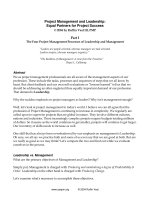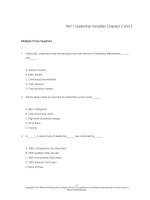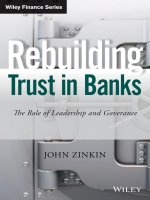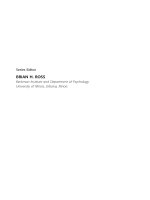Lecture Art of Leadership and Motivation - Lecture 25
Bạn đang xem bản rút gọn của tài liệu. Xem và tải ngay bản đầy đủ của tài liệu tại đây (510.65 KB, 30 trang )
Art of Leadership & Motivation
HRM – 760
Lecture 25
FACILITATOR
Prof. Dr. Mohammad Majid Mahmood
Role of Leaders in
Risk Management
What is Risk?
Risk arises from uncertainty; but all
uncertainties do not carry risk.
Possibility of an unfavorable outcome of an
uncertainty is risk.
3
Is Risk Management a
development planning issue?
Planners are responsible for the protection of
company assets.
Planners must work to improve shareholders’
value, which is not possible without taking
some risks.
Not taking risks may be the biggest risk.
4
Why take risks?
Because you have to.
Because it brings rewards.
5
Risk Management Process
Risk Identification
Risk Assessment
Selection of risk management techniques
Implementation
Review
6
Risk Identification
Risk profile of a company
Formal listing of all potential risks.
External professional help
Risk is inevitable; however unfavorable
consequences of risk can be controlled.
7
Classification of Risk
Production risk
Risk of inputs
Risk of outputs
Environmental risk
Political risk
Economic conditions risk
8
Risk Assessment
Having listed all the potential risks, ask:
How likely is it for any of these risks to
actually materialize?
What is the maximum possible loss that can
arise from each of the listed situations?
Can you stand that loss?
9
Risk Management Techniques
Risk avoidance
Loss prevention and control
Internal controls
10
Internal Control
All that a company does internally to protect
its assets, ensure the proper conduct of its
affairs and accuracy of its records.
Risk management is not just part of
“protecting the assets of a company”, it is an
essential feature of proper conduct of its
affairs.
11
Objectives of
Internal Control
That the company pays only what should be
paid out
That all incomes, expenses, assets and
liabilities are properly recorded
That the assets of the company are protected
That the company’s records are reliable
12
Tools of Internal Control
Defined Procedures
Controls
Physical (cash in safe, maintenance)
Managerial (e.g. budgets, limits, approvals, etc.)
Supervision
Checks
Selection of right personnel
13
Setting Internal Controls
Document all procedures
Train the staff
Ensure that the procedures are being
followed.
14
Designing Procedures
Nature of work.
Extent of risk.
Cost of procedure.
Facilitate work, not hamper it.
Compliance with laws, regulations
Promote efficiency culture
Immediate notice of exceptions
15
Monitoring Internal Controls
The system should generate reports.
Frequency of reports
Adequacy of reports
Regular review of reports and action there
on.
Follow up.
Investigation of major lapses
16
Internal Audit
Includes checking, analyses, appraisals,
recommendations, advice and information.
Regular or Need based.
17
The internal auditor
Detects errors and frauds
Helps management correct errors and
minimize impact of frauds
Helps improve controls.
18
Advantages of
Internal Audit
Keeps workers alert
Timely detection of errors & frauds
Enhances reliability of accounting and
supporting records
Reduces external audit work
19
Types of Internal Audits
Regular, continuous internal audit
Need based investigation
Predisbursement and postpayment audits.
20
Risk Management Reporting
Audit Committee’s Report
Board’s Statement on Internal Controls
21
Audit Committee’s Report
List significance risks; how they are being
identified, assessed and managed.
Report on effectiveness of the systems put in
place to manage these risks
List of actions being taken to remedy
significant weaknesses
Comment on need for greater monitoring of
procedures
22
Board’s Statement on
Internal Control
Essentially it is about status of internal controls, e.g.
There is an ongoing process for identifying, evaluating
and managing significant risks.
It is being regularly reviewed by the Board.
It is in accordance with Turnbull Guidance
23
Turnbull Report
Risk Assessment
Control Environment
Control Activities
Information and Communication
Monitoring
24
Risk Assessment
Clear objectives, clearly communicated to all
concerned.
Significant risks assessed regularly
Market risks
Credit and liquidity risks
Reputational risks, legal risks
25









